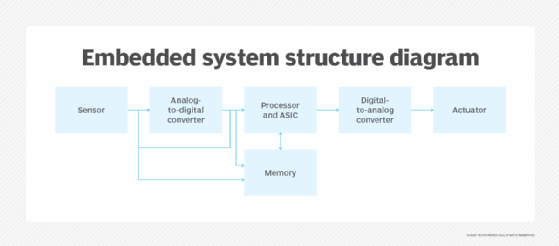5 embedded system terms IoT admins must know (original) (raw)
IoT devices require technology to bring software, hardware and signal processing components together. Embedded systems combine these three elements to streamline IoT product design.
When engineers design an IoT device, they must work to find the right combination of hardware and software to help collect data, streamline UX and perform all necessary functions. Through technological advancements, embedded systems make it easier for devices to process software commands, provide power and run use case-specific workflows.
Familiarize yourself with what embedded systems can do, their components and the different types with a look at some of the technology's main terms.
Embedded systems
Embedded systems blend hardware and software to perform one specific function, such as temperature sensing, data routing, data monitoring or powering an electric motor. They are either programmable or have fixed functionality. Examples include cars, smartphones, industrial machines and medical equipment. IoT-specific use cases are wearables, drones and smart home devices.
Embedded systems often function as part of a larger device, but they are computer systems. They can have a wide range of UI setups: no UI, a complex GUI, interface buttons, LEDs, touchscreens or a remote interface.
These systems also include a processor, power supply, memory and communication ports. The communication ports transmit data to the processor and any peripherals through a specific protocol.
The embedded system's software is often extremely specialized to perform a single desired function. In most cases, engineers use a pared-down Linux distribution but might also use Windows IoT or Embedded Java to run on the system.

Embedded system examples include mobile, networked, standalone and real time:
- Mobile embedded systems are made to be portable. Use cases include smartphones or digital cameras.
- Networked embedded systems connect to a network and provide an output to other systems. These can be home security or point-of-sale systems.
- Standalone embedded systems do not rely on a host system. They perform a specialized task and aren't a part of a larger computing system. These are often digital wristwatches, calculators or home appliances.
- Real-time embedded systems provide a required output at predetermined time intervals. One example is a traffic control system, but these types of embedded systems are often applied to mission-critical use cases.
Admins can also use performance requirements or architectures to categorize the technology.
System on a chip
A system on a chip (SoC) is a microchip that includes all electronic circuits for a system on an individual integrated circuit. The technology is found in small, complex consumer electronic devices, such as smartphones, wearables and IoT sensors.
A sound detection device could include an analog-to-digital converter, memory, I/O logic control and microprocessor all on one chip for designers to integrate into a device. Other SoC configurations may include an accelerometer and a gyroscope sensor for movement tracking.
Application-specific integrated circuit
An application-specific integrated circuit (ASIC) is a microchip manufactured for a special use case. Unlike microprocessors or RAM chips, ASICs usually just run a specific transmission protocol or process; ASICs are also an example of SoCs.
More organizations adopted ASICs for IoT devices because, compared to general-purpose computing chips, ASICs have a smaller form factor, decreased power consumption and lower cost. Vendors can also produce ASICs at a mass scale.
Real-time OS
A real-time OS (RTOS) is one developed to guarantee real-time capabilities within a specified deadline; it often supports critical systems and devices that are timing-specific. RTOSes measure time in milliseconds to ensure all deadlines are met.
These OSes have similar functions to general-purpose OSes but include a scheduler so the system meets task deadlines. The main characteristics of an RTOS include a small footprint, high performance, determinism, security protocols, priority-based scheduling and timing information. With such features, an RTOS offers multitasking, process thread prioritization and interrupt level functionality.
RTOSes simultaneously handle multiple processes, respond to events in a predicted time limit and monitor task priority. These characteristics make them suitable for embedded systems that require real-time operations or data collection.
RTOS use cases include anti-lock brakes, medical systems, PCs, cameras and air traffic control systems.
Digital signal processing
Digital signal processing is a collection of techniques that help improve the accuracy and reliability of digital communications. These techniques work to clarify the levels or states of a digital signal. The circuits that perform digital signal processing are designed to differentiate between human-made signals and general noise.
Noise, which is unwanted electrical or electromagnetic energy, is a problem for wireless systems more so than hard-wired systems. Unwanted noise can affect files and text, image or audio communication; it also degrades signal and data quality.
Two traditional methods to reduce the Signal-to-noise ratio are to increase transmitted signal power and the receiver sensitivity. With adjustments, audio engineers can improve the receiving unit's sensitivity -- and the received signal quality.
Next Steps
A look at how IoT and embedded systems work together
 What are tensor processing units and what is their role in AI?
What are tensor processing units and what is their role in AI?  By: Antony Adshead
By: Antony Adshead  What is a real-time operating system (RTOS)?
What is a real-time operating system (RTOS)?  By: Nick Barney
By: Nick Barney  By: Vladimir Jirasek
By: Vladimir Jirasek  What is a transistor? By: Cameron Hashemi-Pour
What is a transistor? By: Cameron Hashemi-Pour